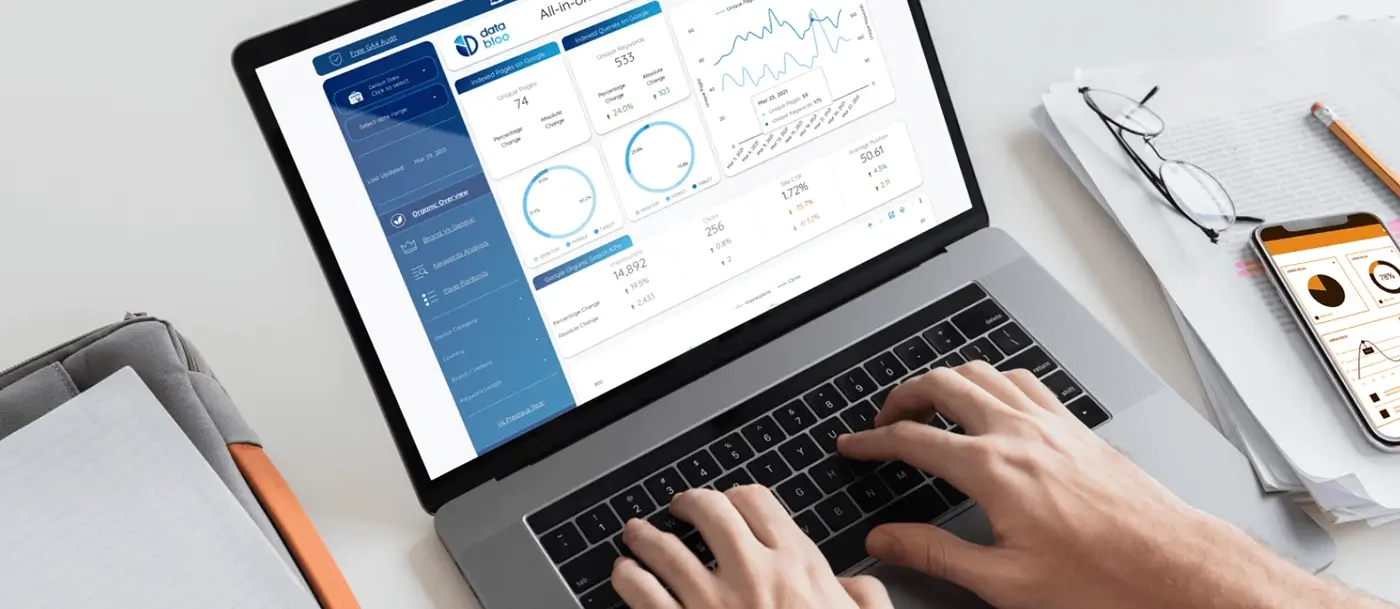When it comes to effective digital marketing, information is priceless. From understanding how users find and navigate your B2B website to evaluating the effectiveness of social media campaigns, you have multiple options when it comes to gathering data to optimize your efforts.
Unfortunately, with multiple channels to monitor at any given time, your data sources are scattered. In a competitive economic climate, especially within the B2B tech industry, you need to quickly recognize and respond to the emerging trends of your marketing efforts. With multiple stakeholders counting on your ability to generate results, you can’t waste time trying to compile all this information into reports that are persuasive and easy to understand.
Digital marketing requires gathering information from all directions at once. However, with Google Data Studio, all your data comes into focus within a single, shareable resource. Capable of being customized to draw the results from multiple campaigns into an interactive dashboard, Google Data Studio is critical to staying on top of your marketing performance.
Using Google Data Studio to Tell the Story Behind Your Data
While the hard data that demonstrates the success (or shortcomings) of your marketing is priceless to your B2B business, one of Google Data Studio’s clearest benefit comes down to its initial cost – it’s free.
But beyond its affordability, Data Studio’s power comes from its ability to bring information together. Given its lineage, the platform readily incorporates data from the multifaceted Google Marketing Platform. Along with displaying critical website KPIs, you can easily incorporate additional insights from tools such as Google Ads, Search Ads 360, and Display & Video 360 into a single view.

In addition to easily gathering data from multiple sources, Data Studio enables you to create interactive dashboard templates that will allow you to tell the story behind your data in a variety of engaging ways. Once you’ve gathered the reports you need, your dashboard can then be shared across your organization.
Rather than needing to worry about reinventing the wheel when it’s time to present your marketing results with stakeholders, you can generate compelling reports and visualizations from the latest data in real-time. Even if you only use Data Studio for its ability to transform Google Analytics into an intuitive, self-service tool, it’s a vital resource for marketers.
Visualize Your B2B Marketing Funnel by Connecting Google Analytics and Data Studio
Though Data Studio is designed to bring together multiple data sources, its connection with Google Analytics opens up new possibilities to help your organization do more with an essential marketing tool.
While Google Analytics requires some technical expertise to customize and configure, Data Studio allows you to quickly transform its insights into a user-friendly display. If your site is already using Google Analytics, Data Studio allows you to optimize your website by illustrating your marketing funnel’s performance.

Through Data Studio, you can easily customize Google Analytics to monitor each step of your customer’s journey. By creating an event in Google Analytics that tracks visits to your website’s product pages or solutions section, Data Studio allows you to quickly recognize the elements in your design that encourage users toward a conversation or where they fall off.
But Data Studio’s plug-and-play capabilities extend beyond its facilities with Google’s tools. Through its ability to compile and combine data from any source, you can also analyze information from wherever your marketing efforts require.
How Google Data Studio’s Connectors Make Business Intelligence Second Nature
One of the strengths of Data Studio is its ability to transform gathering business intelligence insights into an easy, intuitive task. By using its connectors feature, you can blend multiple data sources into a single, readily accessible resource.
Data Studio includes nearly 200 plug-and-play connectors that will populate your dashboards with vital information. Though connectors to Google products are free, others require a monthly fee that could range anywhere from ten to hundreds of dollars a month. Ultimately, your level of investment depends upon the data you want to analyze.

If the connector you need isn’t available, Data Studio also allows you to import your own information from Google Sheets as a data source open to analysis. Once your data is connected, you can then configure the source by applying all the appropriate fields and metrics.
But by tapping the expertise of outside specialists, Data Studio can be further expanded.
Generate Better Insights into Marketing Data with Third-Party Connectors
Supermetrics and Power My Analytics are two of the main providers of connectors that allow marketers to unify information from a broad range of platforms. Offering easy access to data sources such as HubSpot, Amazon, MailChimp, Bing, and various social media platforms, these organizations can provide the tools to bring all your marketing channels together.
These third-party firms can also provide your business with more template options to design the dashboard you need. From compiling SEO data to social media performance, these dashboard templates can be shaped to your specifications. By using its connectors feature, you can blend multiple data sources into a single, readily accessible resource. Granted, if you have the development resources, you could also build your own Data Studio connectors using an API to create a custom link to your dashboard. But that could require hours of specialized work. When it comes to gaining consistent access to the information you need, the monthly costs of the right connector are worth the investment.
Monitor All Your Paid Media Campaigns on a Single Google Data Studio Dashboard
Given the breadth of marketing information available to your B2B firm, even the most advanced business intelligence dashboard will quickly be overcrowded with data and reports. Using Data Studio’s capabilities with blended data, you can combine information from separate but similar channels into a single, interactive resource.

For example, you can use Data Studio to create a paid channel matrix that combines all of your campaign insights into a single page. Instead of separately checking the performance of your Facebook, LinkedIn, and Google ads, you can gather each into a dashboard to compare your return on investment over a specified date range. Then, you can create graphics to illustrate clickthrough rates, cost per conversion, and other metrics at glance.
When a given campaign ends, you can quickly remove any data source. Designed thoughtfully, a paid channel matrix allows you to quickly verify whether your marketing expenditures are delivering a return on investment.
Google Data Studio Brings Digital Marketing Information to the Surface
The insights available in your website and marketing data provide a vital window into what digital initiatives are bringing conversions to your business. Along with its facility with unifying your marketing information, Data Studio transforms it into a clear, actionable resource to keep your stakeholders informed.
With so many marketing channels at your disposal, your business has the ability to expand its reach in multiple rewarding directions. When implemented effectively, Google Data Studio allows you to bring all of your efforts back together.






